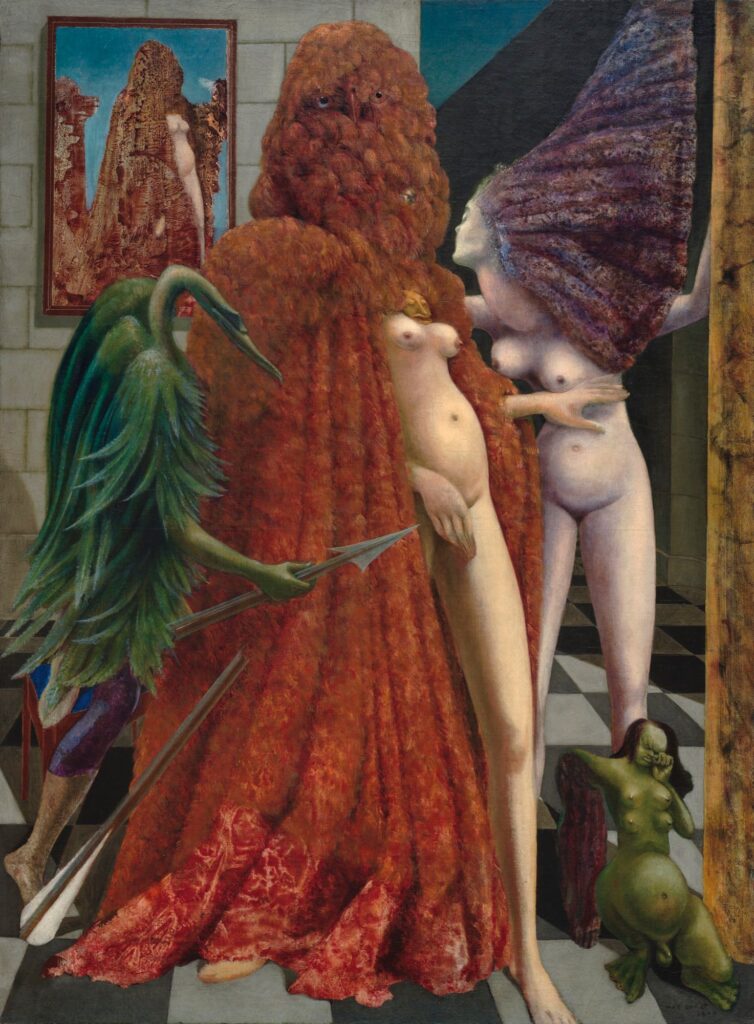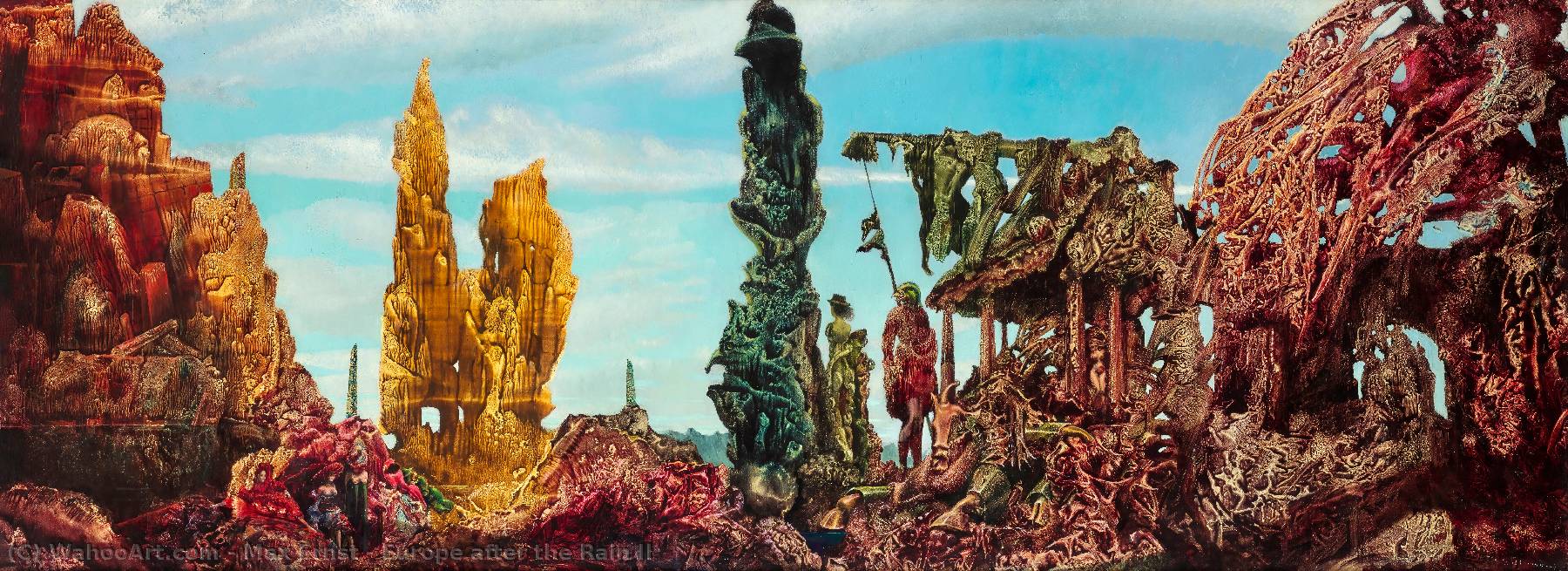

Peggy Guggenheim alla fine degli anni Trenta del Novecento è considerata una delle collezioniste più vivaci del Surrealismo. È in quegli anni che la mecenate acquisisce familiarità con il movimento divenendo presto intima amica di Ernst e Breton.
From 9th April until 26th September at Palazzo Venier dei Leoni over twenty artists and about sixty works form the corpus of the exhibition Surrealism and magic. Enchanted modernity. It is mainly based on the world-class Surrealist holdings of the Peggy Guggenheim Collection, from the metaphysical paintings by Giorgio de Chirico, dated around 1915, to iconic paintings such as The Attirement of the Bride (1940) by Max Ernst and The Lovers (1947) by Victor Brauner, to the occult symbolism of Leonora Carrington’s and Remedios Varo’s works.
Gražina Subelyté, the curator of the exhibition, guides us through the discovery of the alchemical, magical and occult surrealists’ suggestions, a topic which is thoroughly investigated also by Cecilia Alemani, curator of the Biennale Arte 2022 The Milk of Dreams. Subelyté, of Lithuanian origins, graduated in History of Modern and Contemporary Art as well as in Political Science in Germany. After a master’s degree in London, in autumn 2007 she completed a two-month internship at the Peggy Guggenheim Collection. From that moment onwards, she has dedicated herself to the study of the Collection, becoming first assistant to the curator and now associate curator.
When Remedios Varo was asked if Surrealism was in decline, she replied: “I don’t think it can ever go into decline in its essence since it is inherent in humanity
Peggy Guggenheim was among the first collectors and promoters of surrealist art. From a historical and artistic point of view, how did this peculiar predilection of Peggy start and develop and how did it combine with her parallel interest in abstract art?
Peggy’s interest in Surrealism starts from her arrival in Paris in the early 1920’s. Thanks to her first husband, the dada artist Laurence Vail, she met many writers and painters belonging to this movement, including Marcel Duchamp. Duchamp himself guides her into the discovery of modern art and teaches her the difference between modern and abstract art. They are two worlds that interpenetrate and dialogue with each other; within surrealist art we can find shades of abstractionism. In 1938 Peggy opened the London gallery Guggenheim Jeune. Her first exhibition of surrealist art was dedicated to the Danish artist Rita Kernn-Larsen. With the outbreak of the World War II she went back to the United States, helping the founder of the surrealist movement, André Breton, to escape from Europe with his family, and so she did with Max Ernst. As she states in her autobiography, when she was still in Europe at the beginning of the war, she used to buy one painting a day, thus helping Surrealism and its interpreters to be able to survive during the World War.
In October 1942 Peggy opened the Art of This Century gallery-museum in New York. Here she exhibits her permanent collection and organizes temporary exhibitions dedicated to a lot of artists, including Wolfgang Paalen who is present in the exhibition with one of his works. Interestingly, if the war had produced a terrible feeling of separation, Peggy’s gallery designed by architect Frederick Kiesler, was able to create a synesthetic unity. In the surrealist hall the light would turn on and off intermittently accompanied by the sound of passing-by trains and the works were displayed without frames. An absolutely magical set-up. Peggy’s arrival in Venice occurred together with the exhibition of her Collection at the 1948 Biennale. That year also the Greek Pavilion showed a great interest in abstract and surrealist art. Her impartiality towards these two trends characterized her life as a collector and, even today, it is still present in the rooms of Peggy Guggenheim Collection.

Your interest in Surrealism goes back to your past as a student. In fact, your doctoral dissertation at the Courtauld Institute also explores the Surrealist movement link to the magic and the occult, with a particular regard to Kurt Seligmann’s works. How do these worlds relate artistically to each other?
My interest in Kurt Seligmann, an expert in magic, is related to the Peggy Guggenheim Collection. As a curator I also spent a lot of time in our warehouse, where I had the opportunity to see a drawing by Seligmann. This ‘discovery’ strongly pushed me to an in-depth study of a work which was almost unknown. I then went to the United States for another project; I lived near New York, where the artist had his studio: a sign? Perhaps… Seligmann was the first European artist to emigrate to the USA at the outbreak of war in September 1939. He could speak English and helped many other surrealist artists to get the papers for the United States. The artist had been interested in magic since he was a child. He spent most of his childhood reading the books by the Swiss doctor-alchemist Paracelsus as well Emile Grillot de Givry’s works. The result of Seligmann’s in-depth study of this subject is a comprehensive and scholarly monograph, today a classic of the occult, The Mirror of Magic: A History of Magic in the Western World, published in 1948. For Seligmann, and for all surrealists in general, magic started to play an essential role at the outbreak of hostilities. They believed that rationalism had brought about only extermination and pain. According to them progress with its mechanical logic had proved to be a failure. The concept of spiritual freedom thus becomes a fundamental element in the surrealist universe, where the idea of limit is not accepted. The traditional idea of family, ecclesiastical institutions, socio-political choices cannot hinder our mind.
Probably this search for freedom is also one of the main reasons why many women joined Surrealism. The Surrealists wanted to re-enchant the universe. Their goal was to change the world and create a new man experimenting new paths to the discovery of universe and its occult dynamics. To them art was a way to face the primordial fears of humanity and to overcome them; a sort of cathartic process that takes place in a state of “surreality”, as Breton defined it in his The Surrealist Manifesto (1924), which is able to overcome the numerous conceptual oppositions present in our lives. As Arturo Schwarz said, Surrealism wants us to know ourselves in order to change the world surrounding us. It is a way to heal our souls. According to me such a consideration turns to be highly topical today, in a society interested by war, pandemic, environmental and social crisis.
Let’s now speak about the exhibition itself. Which guidelines did you follow in planning your exhibition itinerary and how will visitors be placed in relation with the artists involved?
We worked very hard on this exhibition for four years, managing to obtain loans from all over the world. Surrealism and magic. Enchanted modernity unfolds in the thirteen rooms dedicated to temporary exhibitions of the Guggenheim Collection. After the Venetian venue they will be exhibited at the Barberini Museum in Potsdam, under Daniel Zamani’s curatorship. The exhibition follows a chronological fil-rouge. The works are organized thematically and some of them focus on specific artists. From the works of de Chirico, with his important painting The Child’s Brain, to the Jeu de Marseille, the tarot created by the surrealists themselves, to the Goethe by André Masson. The exhibition goes on focusing on topics such as androgyny, alchemy and its totemic aspects, cosmic unity and infinite analogies until dealing with the subject of woman seen as a magical being. Three rooms of the exhibition are dedicated to this last topic. My aim here is to make a visual comparison between surrealist works by women and men, highlighting the difference in their perception of femininity.
My aim here is to make a visual comparison between surrealist works by women and men, highlighting the difference in their perception of femininity
The exhibition focuses in particular on Leonora Carrington, Leonor Fini, Remedios Varo, Max Ernst and Kurt Seligmann. The last room deals with the cosmic features, a fourth dimension that dwells in the works of Yves Tanguy, Kay Sage, Oscar Dominguez, Salvador Dalí, Roberto Matta and Wolfgang Paalen.

Which Master and work can be considered as the key element and manifesto of the exhibition itself?
Peggy is my first inspiration for this curatorial project. Attirement of the Bride by Max Ernst comes straight from her Collection. Here the artist paints his beloved, Leonora Carrington, as a kind of witch, a very intense and mysterious entity. Ernst had a passionate and troubled love affair with Carrington, interrupted by the war. He later married Peggy Guggenheim, who was aware of the strong relationship still existing between the two artists. For the first time in an exhibition we compare this work with Carrington’s portrait of Ernst. Surrealist painters, who fled to Marseille while waiting to leave Europe for the United States, used to organize Sunday auctions at Villa Air-Bel: it was here that the two paintings were photographed together. After a separation of about eighty years, the two paintings are speaking again to each other in our exhibition.